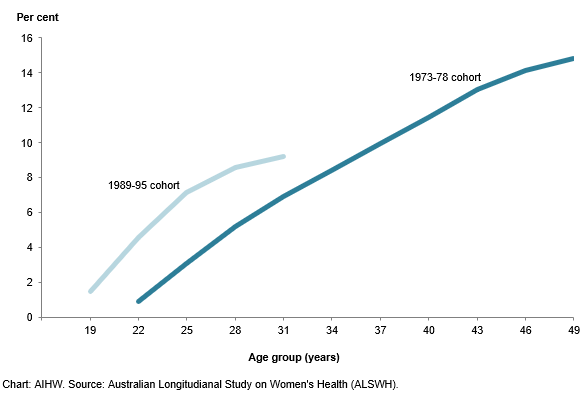How common is endometriosis?
Page highlights
- Around 1 in 7 (14%) women born in 1973–78 were estimated to have been diagnosed with endometriosis by age 44–49.
- By age 31, a higher proportion of women in the younger cohort had been diagnosed with endometriosis (9.2% of those born in 1989–95 compared with 6.9% born in 1973–78).
According to the Australian Longitudinal Study on Women’s Health, 14% of women born in 1973–1978 were estimated to have been diagnosed with endometriosis by age 44–49. This comprised an estimated 7.6% with surgically confirmed endometriosis and 6.6% with clinically suspected endometriosis.
Among a younger cohort of women born in 1989–95, 8.8% were estimated to have been diagnosed with endometriosis by age 26–31. This comprised an estimated 3.8% with surgically confirmed endometriosis and 5.0% with clinically suspected endometriosis.
As expected, the cumulative incidence of endometriosis increased with age as women have more time to receive a diagnosis (Figure 1). Of women in the 1989–95 cohort who had turned 31, 9.2% were estimated to have been diagnosed with endometriosis compared with 6.9% of women born in 1973–78 at this age.
Differences between the two cohorts are also evident in the age-specific incidence rates. To date, the peak age-specific incidence occurred at 22 for the 1989–95 cohort, compared with 25 for the 1973–78 cohort.
These differences may reflect increased awareness of endometriosis among the general public and health professionals, leading to increased diagnosis among women born more recently.
Figure 1: Cumulative incidence of endometriosis, by cohort and age

Estimating the prevalence of endometriosis with the Australian Longitudinal Study on Women’s Health
The Australian Longitudinal Study on Women’s Health (ALSWH) is a national study focusing on women’s health. The ALSWH provides information about endometriosis among women in 2 specific cohorts – those born in 1973–78 and those born in 1989–95. Researchers from the University of Queensland used data from surveys of women in the study, linked with administrative health data, to estimate the prevalence and cumulative incidence of endometriosis in these cohorts. The estimates were based on:
- participant-reported diagnosis of, or treatment for, endometriosis
- records of claims for an endometriosis specific Medicare item
- records of dispensed endometriosis-specific medications subsidised under the Pharmaceutical Benefits Scheme
- hospitalisations where a diagnosis of endometriosis was recorded.
The estimates were further categorised into surgically confirmed and clinically suspected endometriosis. Surgically confirmed endometriosis was defined as participants who had a diagnosis of endometriosis recorded in the Medicare Benefits Schedule (MBS) or hospitals data. Clinically suspected endometriosis was defined as participants who self-reported a diagnosis of endometriosis in the ALSWH only, or who had only been prescribed a restricted medication for endometriosis based on Pharmaceutical Benefits Scheme (PBS) data.
For further information on the data sources and methods used in this research, see the Technical notes.
Other Australian prevalence
There is a lack of comparable Australian prevalence estimates in recent decades. In an earlier Australian study, a questionnaire of around 3,000 female twins aged 18 and over conducted in 1993–1994 found that 7% of respondents had ever had endometriosis (Treloar et al. 1999). The twins were considered representative of the general population, with regard to age, education and marital status.
International prevalence estimates
In international research, the prevalence of endometriosis is estimated to be about 10% among women of reproductive age (WHO 2021; Zondervan et al. 2020). This estimate is based on a United States study conducted from 1976 to 1984 which identified histologic diagnosis of endometriosis among 858 women undergoing vaginal hysterectomy for preoperative diagnoses excluding endometriosis, pelvic pain and adhesions (Wheeler 1989). A more recent United States study involving an online survey of women aged 18–49 estimated the prevalence of diagnosed endometriosis as 6.1% (Fuldeore & Soliman 2017).
Fuldeore M & Soliman A (2017) ‘Prevalence and symptomatic burden of diagnosed endometriosis in the United States: national estimates from a cross-sectional survey of 59,411 women’, Gynecologic and Obstetric Investigation, 82:453–61.
Pugsley Z & Ballard K (2007) ‘Management of endometriosis in general practice: the pathway to diagnosis’, British Journal of General Practice, 57:470–6.
Wheeler J (1989) ‘Epidemiology of endometriosis-associated infertility’, Journal of Reproductive Medicine, 34:41–6.
WHO (World Health Organization) (2021) Endometriosis, WHO, accessed 1 November 2022.
Zondervan KT, Becker CM & Missmer SA (2020) ‘Endometriosis’, New England Journal of Medicine, 382:1244–56. doi:10.1056/NEJMra1810764


